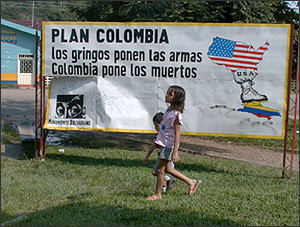
San Vicente del Caguan, Colombia April 14, 2001
In main plaza in San Vicente a billboard facing the town church reads:
"Plan Colombia: The gringos supply the arms and Colombia supplies the
dead."
San Vicente del Caguan, Colombia, April 14, 2001
The billboards which greet visitors to the guerrilla-controlled county of San Vicente del Caguan come in differing versions but with a singular message: "No to gringo intervention in Colombia."
So I am a little surprised when the Revolutionary Armed Forces of Colombia (known as the FARC) greet me exactly in the manner I've come to expect from other Colombians--with questions about my perceptions of their country, their people, their problems.
I find Colombians to be proud, with strongly held if sometimes guarded opinions. Sometimes their curiosity about my views is to determine if I pose a potential threat or an opportunity. Generally the interest is also passionately and palpably genuine.
In these and other ways I find the FARC to be deeply Colombian. In much of Latin America, people co-exist in realities that are centuries apart. The rigors of peasant life in frontier villages like San Vicente del Caguan in some ways more closely resemble the hardships faced by westbound settlers in the early 20th century United States than the lives of yuppies in Bogota, New York or Paris in 2001. FARC ideology reflects this Colombian reality. It is an amalgam of revolutionary ideas from the 19th and 20th centuries--from Bolivarian nationalism to Marxism-Leninism.
The camp where I spend the night is located far from the front line
battlegrounds. The more than 500 troops who have come here from differing fronts in the war will get a little R & R and some education workshops during their brief stay. Although there is no tension, the atmosphere is rigorous. The FARC express varying levels of uncertainty and distrust in the peace process and a firm belief in maintaining security through military discipline.